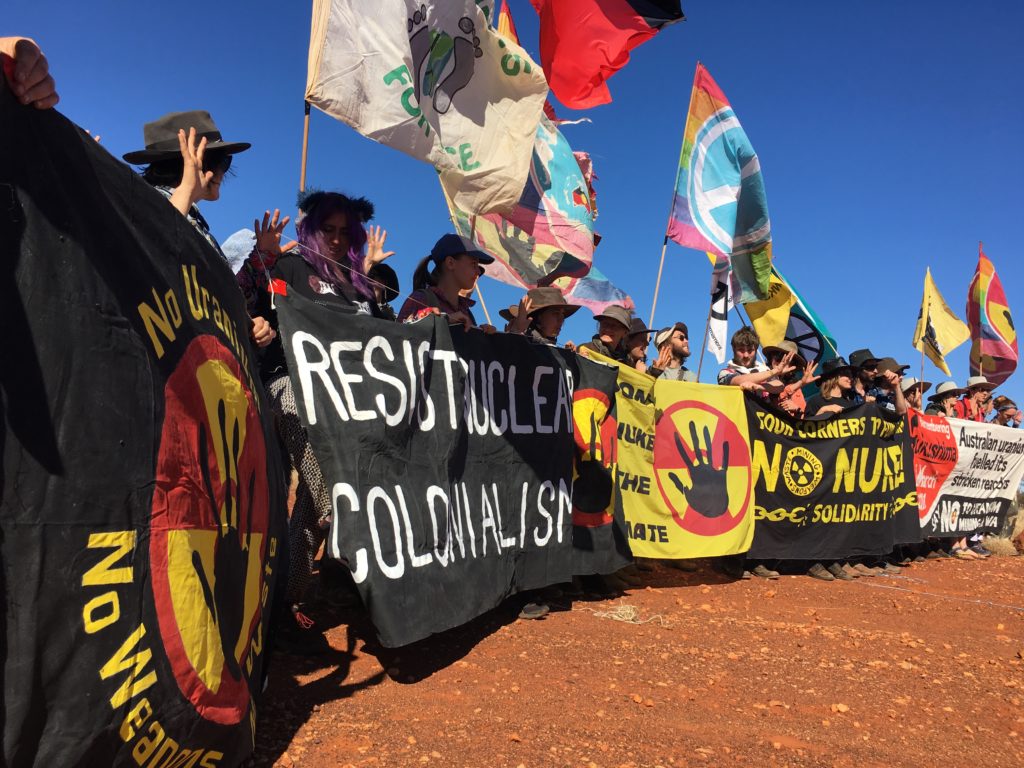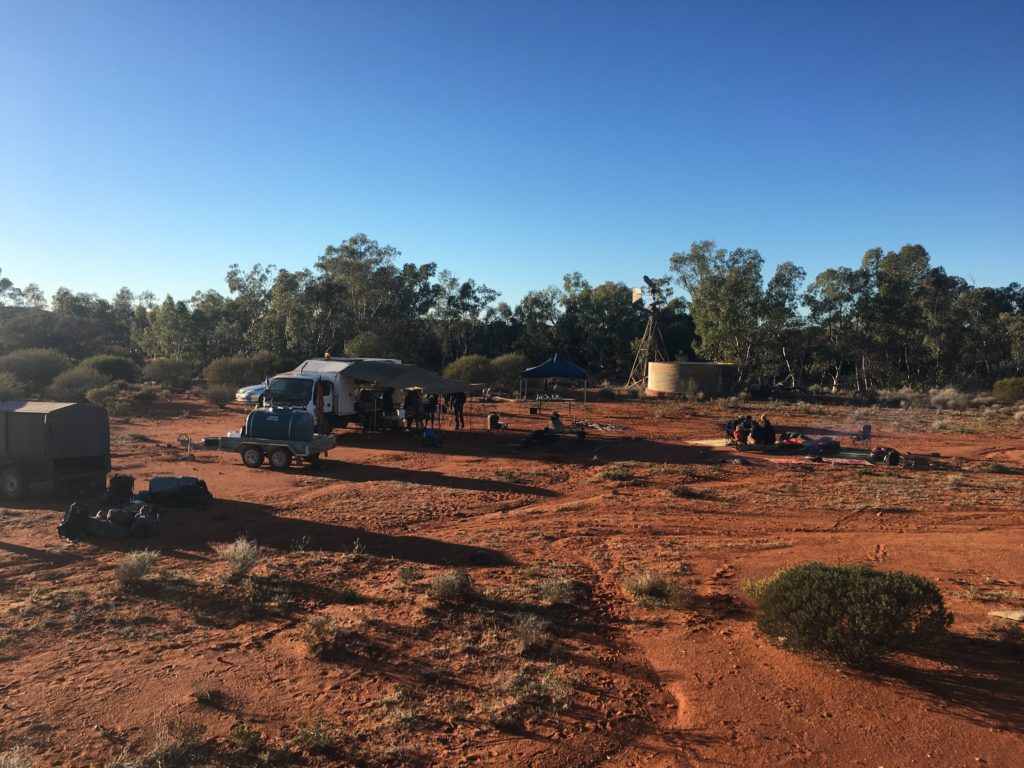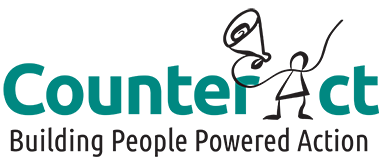Feature image: A strong wind buffets walkers and stretches out the flags of the Walkajurra Walkabout in August 2018.
In August 2018 I joined Footprints for Peace and the WA nuclear free Alliance on the Walkajurra Walkabout, walking 250kms from Wiluna to Leonora on Wangikatja Country. Here’s what I learned.
After I crawled out of the desert, and washed all the red sand out, I needed a good few weeks to readjust to life in Melbourne. For a while I wasn’t quite sure which was more real: the desert, where one must fall into the rhythms of nature – or the city, where life suddenly seemed so removed from, well, life.
I had walked into the desert deliberately ignorant, leaving learning about the anti-nuclear campaign to face to face interactions rather than research on a computer screen. It was an amazing month, that felt too complex to explain to people back here in the city. It’s been four months back in the white bubble of Melbourne life. It has taken me this long to digest my experience.
The basic low down:

The Walkajurra Walkabout is a peace walk, run by footprints for peace and the WA Anti Nuclear Alliance. A peace walk is a form of nonviolent action where a person or groups of people march a set distance to raise awareness of particular issues important to the walkers.
The WA nuclear free campaign, lead by indigenous people, has been fighting for over forty years to protect country, scared sites, and to stop uranium mining at Yeelirrie. Their animation, released last year, explains the current situation.
About Making Cups of Tea
The month out in the desert is hard to talk about because walking in the desert was like living in a different world, and there’s so much context, so much ‘you had to have been there’ to really ever explain it to anyone. It’s especially hard to explain anything when you’re audience hasn’t got their head around the basic premise that we’re walking on aboriginal land.

It felt tempting to satiate people’s curiosity about my time in the desert with the simple things. What food we ate out in the desert, how we got from A to B, or the daily digging of gunna (poo) pits. All of that stuff is offensively irrelevant. We need to be talking about important things. Like making tea. I’ve included a handy recipe here for those that want to give it a go.

Making tea is a way to show your respect to elders and to mob. Even if they’re not thirsty, offering shows that you care. Step five is probably the most important. In the first few days of the walk I was feeling a lot of pressure to take photos and do interviews, which was easy when it came to my city friends on the walk, but I wanted to centre mob voices on social media. I didn’t know what to ask, how to ask, when to ask, and I was terrified of being that ignorant white activist that shoves a well meaning foot in the middle of everything. There is a lot of etiquette, culture and rules that I didn’t know – that I don’t know. I sought advice from the organisers of the walk. They told me that the best place to start was to go and sit by the Auntie’s fire – just sit and listen. So for the rest of the walk I did just that. I made cups of tea, I collected firewood for the mob, I sat by the fire and listened, I offered help and gave it when it was asked. I learnt that it is important to build trust and give people a chance to see what I was about before barging in with a camera and microphone. The importance of building trust and genuine longterm relationships with the people you’re campaigning with is one of the biggest things I have taken out of the walk.
Sustainable, long-term, and genuine campaigning

When it comes to the Walkajurra Walkabout, there are genuine long-lasting friendships between the white allies in Perth & Freo, and the communities on the front line fighting uranium. It’s a sustainable long-term campaign. This isn’t a big NGO jumping on a hot issue, fighting and blockading for a year or two then jumping onto the next bandwagon and leaving the locals behind.
Reflecting on campaigns and organisations that I have been involved with or know from Melbourne I struggle to name any that have a strong relationship with local mob and work with indigenous sovereignty as a core value. We’re walking on stolen land – we’re campaigning to save stolen forests, stop mines on stolen land – If we’re not putting sovereignty at the heart of our movement then we’re no better than the rest of ‘em. It’s hard, it’s complicated, but it’s high time we stepped out of our white bubble culture comfort zones and learnt to get along with indigenous mob on their terms, by their culture and processes, in their language and on their land.
One of CounterAct’s core objectives is to support the Aboriginal community in asserting self determination, increase awareness among non-Indigenous communities to accept and promote Aboriginal leadership, and work in effective solidarity in organising for environmental and social justice. That’s why I am proud to be a part of the CounterAct team. I feel confident in what I’m learning through their guidance.
The White Bubble
Returning to Perth and then Melbourne from the desert, I was wholly convinced of the existence of what I like to call The White Bubble. The white bubble is made up of a life filled with white friends, a white job, white issues, and white spaces. It’s comfortable in the white bubble. You can step out of it for some sight seeing, and it’ll be there waiting for you to come home to. As a white activist I have the option to engage, or not engage with issues. I can go into the desert, and at the end of it all, I can return to the city, back into a world without reminders. I don’t have to deal with sovereignty everyday, it doesn’t affect my opportunities for education, or health, or happiness. I can read the news, and that’s all it is – news, on my phone screen, which goes back into my pocket while I focus on other things.
Out on the walk there’s limited electricity and reception – so no phone, no music, no internet – no distractions to take your mind off things. The Walk is a powerful way to engage people because if you’re out on the walk you’re committing 100% of your attention, and there’s no white bubble to hide in.
This was another big lesson I took from The Walk. People who came out had the opportunity to experience walking on country and develop a real, meaningful and lasting connection with the campaign. That’s a million times more powerful than dropping in to a rally on Spring St. This video I made from The Walk talks more about my own experience of walking on country.
If you take the Alamein or Belgrave line out of the city, and keep looking out the left hand side of the train as you approach the river, you’ll see the face of an aboriginal boy. The face fills the whole side of a building. He looks right at you and his eyes are piercing. I’ve seen a few of Matt Adnate’s murals of aboriginal faces around Melbourne, but it wasn’t until I came back from the walk that I could work out why I found them so powerful. Like the jolting feeling of breaking the fourth wall in a theatre show and being returned to reality, the boy on the Alamein line pierces through my white bubble as I fly past on the train. It’s a powerful reminder that I walk on stolen land.
Matt Adnate’s murals are controversial and not all indigenous mob agree with his work.
Continued Self Learning
Back in 2014 I found out how to access university timetables, and started crashing lectures. At the top of my self made timetable were the Indigenous Studies lectures. These were an invaluable first step and guided me to resources, like the First Australians series, and John Pilger’s Utopia. I was finally learning the history that they didn’t teach at school.
I think one of the most powerful things I can do as an activist and ally is to break down that white bubble by continually educating myself, and stepping up to the responsibility to be an ally and accomplice when it comes to Indigenous sovereignty. We have a fantastic resources page on solidarity here, and with Jan 26 looming this article from last year is an important read, with heaps of links, tips, and resources.

